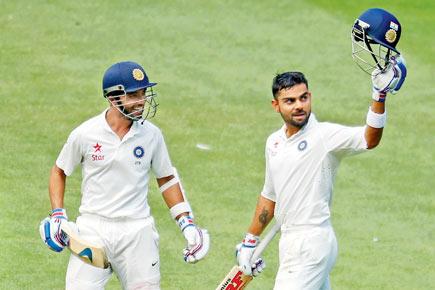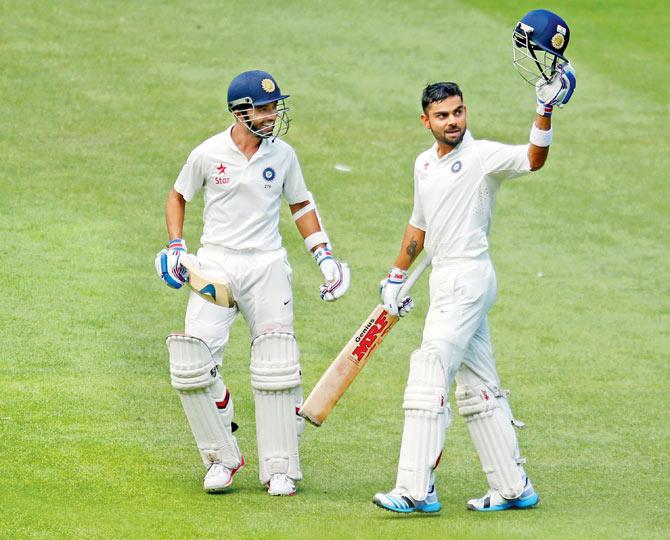Ian Chappell writes on how 'pick 'em young and watch 'em flourish' is no longer the Australian credo, hails India for finding good replacements for Tendulkar, Dravid, Laxman, Ganguly and Sehwag

Indiau00c3u00a2u00c2u0080u00c2u0099s Ajinkya Rahane is delighted for fellow batsman Virat Kohli, who raises his bat after completing a century against Australia in the Melbourne Test on December 28, 2014 Pic/Getty Images
One of the commentators on the Australia versus West Indies series cited the success of Adam Voges, with his debut Test ton at age 35, as an example of the strength of the country’s cricket.
I’d argue the opposite. Australia’s need to turn to an advanced-aged cricketer in Voges - and others like him previously - is an indication the system is failing to produce enough ‘Test match ready’ young batsmen.
ADVERTISEMENT
Australia was once a leading proponent of the “pick ’em young and watch ’em flourish,” philosophy. That’s no longer the case and the ancient arrivals in Marcus North, Ed Cowan, Rob Quiney, George Bailey, Chris Rogers, Alex Doolan and now Voges, is evidence the system is, if not broken, at least in need of serious attention.

India’s Ajinkya Rahane is delighted for fellow batsman Virat Kohli, who raises his bat after completing a century against Australia in the Melbourne Test on December 28, 2014 Pic/Getty Images
The last batsman selected for Australia in his early 20s was Steve Smith but he made his debut as a leg-spinner, batting at No 8. David Warner was reasonably young when he commenced Test cricket but he first came to prominence as a T20 batsman.
Before that, the prolific young Australian batsmen who arrived via the traditional route, were Michael Clarke and prior to him, Ricky Ponting. The presence of Ponting, Clarke and Smith on that list, highlight one of the important reasons to produce batsmen capable of receiving their baggy green cap around the same time they’re entrusted with the front-door key (21st birthday). These types of players are potential captains because by the time they reach 27, the ideal age to begin leading, they’re both experienced and mature cricketers, still in their playing prime.
However, there are many good reasons to ensure there’s a constant supply of young cricketers being fed into the first-class system, with the potential to reach international standard. The infusion of youth into a cricket team invigorates the older players in the side and at international level it titillates the fans. The arrival of a young Sachin Tendulkar or a Ponting enthuses the fans so they either hurry to the ground or watch them on television in order to make a personal evaluation of the player.
These players are not only the immediate future but when they produce exciting performances they also inspire the next generation to try and emulate their feats.
Older debutants have a tendency to succeed in the short-term - on the basis they’ve been around long enough to know how to either accumulate runs or snag wickets - but this success tends not to be long lasting. There’s usually a simple reason why a guy doesn’t debut in Test cricket until after he’s thirty; he’s not been good enough to oust the incumbents.
Selectors are constantly on the lookout for exciting young players to inject into a national side. They do so, both to improve the immediate performance and also to ensure there isn’t a log jam of older players who have to be replaced around the same time.
Presently, no other team but India could’ve replaced Tendulkar, Rahul Dravid, VVS Laxman, Virender Sehwag and Sourav Ganguly in such a short space of time and still retained a prolific batting line-up. The Indian production line of young batsmen is the gold standard in cricket, while the Pakistan selectors are the most ambitious when it comes taking a chance on youth.
The technique and flair of the good young Indian batsmen suggests they’ve been spared the ‘assembly line’ style of coaching. There’s much to recommend in the inventiveness of the golf ball and stump training of young Don Bradman, or a youthful Garry Sobers using a wooden picket to hit a rock wrapped in tape on the rough back streets of Barbados, or the baby-faced Tendulkar regularly batting in different matches on the same day, as he honed his skills on the Mumbai maidans
Aging batsmen like Voges make a good story when they successfully debut but the best teams are usually a combination of experienced and youthful cricketers. Australia needs to look at a more flexible system of producing and grooming young batsmen because it requires many good ones playing at first-class level to provide a few of international standard.
 Subscribe today by clicking the link and stay updated with the latest news!" Click here!
Subscribe today by clicking the link and stay updated with the latest news!" Click here!







